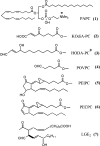The role of oxidized phospholipids in atherosclerosis
- PMID: 19059906
- PMCID: PMC2674746
- DOI: 10.1194/jlr.R800074-JLR200
The role of oxidized phospholipids in atherosclerosis
Abstract
There is increasing evidence that oxidized phospholipids (OxPLs) play an important role in atherosclerosis. These phospholipids accumulate in human and mouse lesions. Specific OxPLs have been identified as major regulators of many cell types present in the vessel wall. In endothelial cells, >1,000 genes are regulated. Some of these genes are pro-atherogenic and others anti-atherogenic. The anti-atherogenic effects are likely important in slowing the atherogenic process. Several receptors and signaling pathways associated with OxPL action have been identified and shown to be upregulated in human lesions. A structural model of the mechanism by which specific OxPLs serve as CD36 ligands has been identified. Specific oxidized phospholipids are also present in plasma and associated with Lp(a) particles. In humans, OxPL/apolipoprotein B has been shown to be a prognostic indicator and a separate risk factor for coronary events. Levels of OxPL in plasma have been shown to be correlated with platelet activation. The results of these studies suggest an important role for OxPL in all stages of atherosclerosis.
Figures

References
-
- Bochkov V. N. 2007. Inflammatory profile of oxidized phospholipids. Thromb. Haemost. 97 348–354. - PubMed
-
- Podrez E. A., E. Poliakov, Z. Shen, R. Zhang, Y. Deng, M. Sun, P. J. Finton, L. Shan, M. Febbraio, D. P. Hajjar, et al. 2002. A novel family of atherogenic oxidized phospholipids promotes macrophage foam cell formation via the scavenger receptor CD36 and is enriched in atherosclerotic lesions. J. Biol. Chem. 277 38517–38523. - PubMed
-
- Salomon R. G. 2005. Isolevuglandins, oxidatively truncated phospholipids, and atherosclerosis. Ann. N. Y. Acad. Sci. 1043 327–342. - PubMed
-
- Zimman A., K. P. Mouillesseaux, T. Le, N. M. Gharavi, A. Ryvkin, T. G. Graeber, T. T. Chen, A. D. Watson, and J. A. Berliner. 2007. Vascular endothelial growth factor receptor 2 plays a role in the activation of aortic endothelial cells by oxidized phospholipids. Arterioscler. Thromb. Vasc. Biol. 27 332–338. - PubMed
-
- Erridge C., D. J. Webb, and C. M. Spickett. 2007. Toll-like receptor 4 signalling is neither sufficient nor required for oxidised phospholipid mediated induction of interleukin-8 expression. Atherosclerosis. 193 77–85. - PubMed
Publication types
MeSH terms
Substances
Grants and funding
LinkOut - more resources
Full Text Sources
Medical
Miscellaneous

